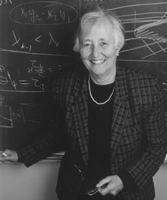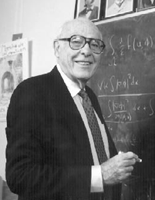Morawetz Receives National Science Medal
January 22, 1999

Cathleen Morawetz
A decade before it would become culturally acceptable, Morawetz's ambition led her to produce results on transonic flow---results that, in the words of her Courant colleague Robert Kohn, "greatly influenced theoretical and practical thinking about airfoil design." In the subsequent years of a remarkable, multifaceted career, Morawetz has made further deep mathematical contributions---analysis of the scattering of waves from obstacles, a scattering theory for nonlinear wave equations, and extended work on fundamental questions in transonic flow being a few highlights.
At the same time, she has been a distinguished leader in the mathematical sciences community, both at Courant and nationally. As president of the American Mathematical Society (1995-97), Morawetz was "extraordinarily effective, taking a broad and inclusive view of mathematics," according to her SIAM counterpart Margaret Wright. "Her visible and unselfish dedication," Wright says, "gives her unquestioned credibility as a spokesperson for the mathematical sciences." Joseph Keller, a colleague of some 50 years, points out that "the set of directors of the Courant Institute has been a very impressive group of mathematicians; Cathleen [Courant's director from 1984 to 1988] was an appropriate member of that group."
In December, culminating a long string of awards and honors, Morawetz was named one of nine recipients of the National Medal of Science. "I am filled with gratitude to all those, and there were a great many, who helped me over many years," she said of the award. "I am proud," she continued, "to be the first woman mathematician to receive the medal. My biggest wish would be that it could help move more women forward in mathematics be it in grade school or graduate school."
Persistent Interest in Transient Flow
Born in Toronto (a daughter of the Irish mathematician John L. Synge and a great niece of the Irish playwright J.M. Synge), Morawetz has been at Courant almost without interruption since the late forties, when as a graduate student she edited the book Supersonic Flow and Shock Waves, by Richard Courant and Kurt Friedrichs. Editing that book, points out Joe Keller, who was also at Courant at the time, "meant that she knew the subject inside out." Courant and Friedrichs acknowledged her in their preface not only for outstanding editorial work, but also for "invaluable criticism," Keller recalls, agreeing that "she was always a good person to ask for advice." In 1951, with a dissertation on imploding shock waves, she received her PhD.
In the fifties, inspired by Lipman Bers and Friedrichs, she began her work on transonic flow. At the time, Robert Kohn explains, the theory of the equations---"neither hyperbolic nor elliptic but a mixture of the two"---that describe such flows was very poorly developed. Morawetz nonetheless was able to prove that "almost all" airfoils produce shocks and thus drag. More precisely, she showed that if a shockless airfoil were to be designed, even small changes in the shape (of the sort that could be caused by manufacturing errors) would result in an airfoil that had shocks. This discovery, based on her ingenious estimate for the equations of transonic flow, coupled with basic methods of mathematical analysis, was subsequently confirmed experimentally.
Important insight on the problem, as Morawetz points out in her retiring AMS president's address (published in the Notices of the American Mathematical Society, January 1999), came from Paul Garabedian, who designed airfoils that at certain speeds would have no shocks; when shocks did develop, they were weak and thus had little effect on the drag. As a result of Morawetz's and Garabedian's work, today's airfoils are designed so that over some range of speed, the drag produced by the shocks is minimized on average.
During the sixties, turning her attention to the scattering of waves by obstacles, Morawetz showed that disturbances near star-shaped obstacles would radiate to infinity and the energy near the obstacle would decay like a negative power of time. Later, she, Lax, and Phillips showed that in three dimensions the decay is exponential. The main tool she used in this work, according to Andrew Majda, is a family of ingenious energy identities, totally different from the usual energy identities of mathematical physics. These identities have been central to modern theories of hyperbolic and mixed-type partial differential equations.
In a 1977 paper, Morawetz, Ralston, and Strauss, making use of the techniques of microlocal analysis, extended the earlier results on exponential decay to the most general possible class of shapes. Ralston had shown that some shapes will not have a rate of decay. Morawetz and Strauss further exploited the identities to develop a scattering theory for semilinear wave equations.
Alvin Bayliss of Northwestern University looks back on work on nonlinear wave propagation he did with Morawetz during the late seventies and early eighties. The limiting amplitude principle, which Morawetz had pioneered, is an appropriate computational technique for linear wave problems, he explains. She and Greg Kriegsmann were working on the nonlinear problem, investigating the interaction of a laser beam with a plasma pellet "and getting some strange results; things did not settle down to steady-state behavior."
"The thing about Cathleen," says Bayliss, who joined in the effort at that point, "is that she would not let a problem go." After a year, she came up with the explanation that there was a pulse traveling through the pellet under the radiation.
Returning in the eighties and nineties to fundamental issues of transonic flow, Morawetz was among those who, in the absence of proof that the usual equations---steady, irrotational, inviscid, two-dimensional flow---actually have solutions, questioned the validity of the model. In a series of "highly original" papers, Kohn explains, Morawetz developed an approach to the mixed equations of transonic flow analogous to that developed by Tartar and DiPerna for hyperbolic equations. Working with Gamba, Morawetz "identified an appropriate family of regularized problems; and assuming some very plausible bounds, she justified the passage to the unregularized limit, obtaining a 'weak' solution of the equations for transonic flow."
Working Together for Common Aims
Former SIAM president Margaret Wright looks back on the two years during which she worked closely with Morawetz in her role as president of AMS as a time when "the two mathematics research societies worked together for their common aims of supporting research in the mathematical sciences, and strengthening and creating connections across mathematics and with other fields." Many of these joint activities, Wright adds, "were hatched and nurtured at lively, lengthy AMS-SIAM 'summit lunches' at small restaurants near Courant."
On a personal level, Wright says, "Cathleen has a remarkable ability to get things done, and done extremely well. She could give lessons to us all in political acumen. Everyone who knows Cathleen will testify to her warmth, sense of humor, wit, and charm. In addition to respect for her accomplishments as a mathematician, she inspires deep affection and loyalty."

Also among the nine scientists named by President Clinton in December to receive the 1998 National Medal of Science was John W. Cahn, a materials scientist at the National Institute of Standards and Technology. The first NIST scientist to receive the medal, Cahn was recognized for his contributions to the fields of materials science, solid-state physics, chemistry, and mathematics. He has been at NIST since 1977 and was named a NIST Fellow in 1984.
Cahn is most widely known for his pioneering work on the thermodynamics and kinetics of phase transitions and diffusion and on interface phenomena, as well as for the discovery, with others, of the quasiperiodic solids known as quasicrystals. Known to the applied and computational mathematics community for his modeling work in materials science and for the Cahn-Hilliard equations, he was a member of the organizing committee for the SIAM Conference on Mathematical Aspects of Materials Science, held in Philadelphia in 1997. He has also given invited talks at SIAM meetings, including the annual meeting in 1993, where he described the creation and motion of interfaces during phase transitions, and an earlier meeting of the SIAM Activity Group on Dynamical Systems.

